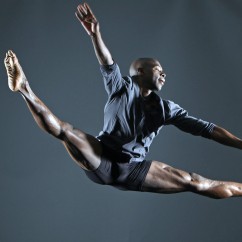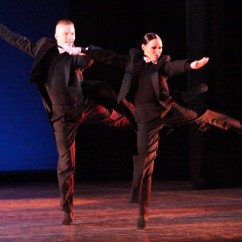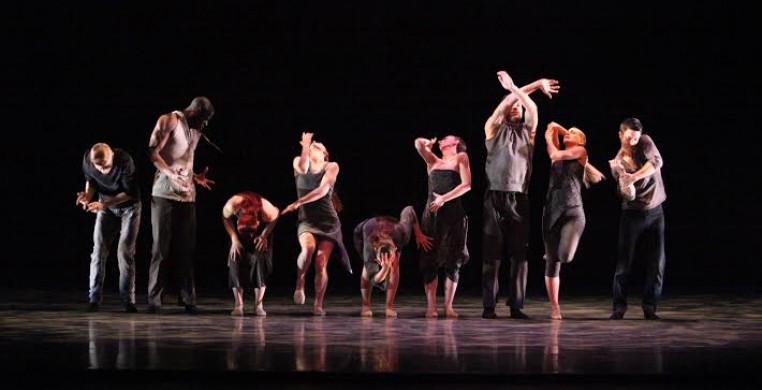After last night’s rocket-fueled “Made In Chicago” performance at the Auditorium Theatre you may be wondering where you can get ahold of the mega-vitamins that nourish Giordano Dance Chicago.
Not your generic one-a-days, these vitamins are a unique prescription for inspired dancing, and you won’t find them on your neighborhood pharmacy shelf. What’s more, they consist of some pretty ephemeral ingredients that take years of studio work to synthesize and refine, like 5 gazillion mg Vitamin T, supplying 100% daily requirement of Trust in each other, Teamwork, and Terrific Technique; Vitamin B for unwavering Belief in the artistic legacy and forward-thinking vision of founding director Gus Giordano, and special Giordano-formula Vitamin L for Love, which radiates across the stage from one dancer to the next like a current of electricity.
You can’t package these vitamins; you can’t brand them or market them, but they are the essential qualities that distinguish this superb company of dancers and enable them to outdistance themselves with every concert. These are also among the qualities that made Saturday night’s concert stand out as a stunning testimony to the unique place Giordano Dance Chicago has earned among Chicago’s finest dance makers.
There are other contributing factors, to be sure, once you acknowledge the energizing cohesiveness of the dancers, each and every one of whom is a virtuoso artist in his or her own right. There is the ever-evolving, deepening physical and emotional understanding of the repertoire and the specificity of style, attack, and dramatic intention required of highly contrasting choreographic material. The maturing that this commitment entails has been in steady ascent since the company’s move to its downtown Chicago headquarters under the artistic direction of Nan Giordano and executive director Michael McStraw. For Giordano Dance Chicago, it’s not just a matter of knocking the socks off their audiences with high-voltage dancing and technical brilliance; it’s taking that energy and virtuosity to the next level and using those tools to breathe individual life and meaning into each piece they dance.
But at the top of my list is programming. Where many highly competent companies perform programs in which one dance looks and sounds pretty much the same as the next, Saturday night’s program exemplified a refreshing distinctness and versatility that expands the boundaries of what we understand jazz dance to be.
I had seen four of the five pieces on the program at least once before, the one exception being Randy Duncan’s exquisite “Can’t Take This Away” (1997). Before he died, Gus Giordano told his daughter, Nan, that he would love to see Randy’s piece in the company repertoire. “Can’t Take It Away” made its first Giordano Dance presence at the founding director’s funeral, which no doubt contributed to the dancers’ exalted performance this past weekend. Even before dancers infused the stage with Duncan’s lush lyricism, the soaring vocal resonance of the family Bournés, singing a cappella on stage in red choir robes, filled the darkened space of the Auditorium with a heavenly aura. Gregory W. Slawko’s fuchsia and red-toned gowns and flowing pants gave wings to the fifteen dancers, whose buoyant leaps and spirals well could usher any soul to heaven, and in fact, gave a great preview of the hereafter for the living fortunate enough to experience their performance. Of particular note is Devin Buchanan’s expansive ease and anointed presence in a solo rendition of “He’s Got The Whole World In His Hands,” (which he certainly did!) and Duncan’s deft use of opposing circles within circles of rushing women, the men rising from within their enclosure to float, miraculously above them. The whole culminated in a breathtaking exaltation of dancers out into the aisles of the theater and back to the stage to join their singing fellow angels. Devin Buchanan
Devin Buchanan
Beginning the program, Ronen Koresh’s “Crossing/Lines” (2015) introduced a completely opposite energy of high-stakes movement, characterized by forceful thrusts, strikes, kicks, deep second-position pliés, and loose upper body abandonment to tossed arms and shimmying shoulders. Percussive strength was the predominant quality, with powerful flexed-foot pogo-stick springs, legs splayed in the air. Mood shifts from ominous to light-hearted, from combative to celebratory kept the visual and auditory palette shifting with plenty of spills to the floor and gravity-defying leaps. The piece, divided into six sections, used unison large group movement and small ensemble interludes to effectively showcase the company. Ashley Downs and Rachael Berube made a playful duet of frothy celebration in “bang bang banging,” to the music of Leo Abrahams, and the six men of the company shone in the precision ensemble work of “round the block,” to the music of Pentaphobe. Culminating in “hava nagila,” a send-up of a candy-bar commercial, the dancers unleashed a wacky sense of communal humor for Koresh’s mix of the sublime with earthy crawls, quirky twitches, wild facial exaggerations, and stomping gorilla runs.
The second half of the program opened with a reprise of Ray Leeper’s “Feelin’ Good Sweet” (2014), a crowd-pleaser that turns clichés of Broadway jazz dance on its ear in a crisp delivery of snazzy moves, snappy spatial configurations, and all-out, feel-good fun that makes you look at the idiom with fresh eyes. Spectacular dancing from Maeghan McHale, feelin’ especially good front and center throughout the evening, lit up the stage with all of her sparkling fingers and toes. She just gets better and better, topping her delicious portrayal of the seductive temptress with nuanced phrasing, dramatic subtlety, and wonderful comic timing. Luxuriating in the slinky moves of the dance hall showgirl in Emily Nelson’s revealing black and red corset and black fishnet stockings, she completely sidesteps of the traps of stereotype by virtue of her inner “good Irish lass,” breathing the freshness of discovery into it all.
A second viewing of Brock Clawson’s “Sneaky Pete” (2016), elucidated the choreographer’s use of three different composers (Kerry Muzzey, Abel Korzeniowsi, and Adam Crystal) to evoke the quality of film noire, build dramatic suspense, and provide a context for a sense of story movement, however abstracted. Here again, the company has sunk all its many wondrous limbs into the fabric of the movement, enriching the performance with an enhanced sense of attenuated line, varied phrasing, and overall physical momentum. Coming into even sharper focus are Zachary Heller’s piercing intrusions as “Leading Actor” in small eruptions of dancing brilliance around the periphery of the ensemble.
A retooling of Gus Giordano’s iconic “Sing, Sing, Sing” (1983), to the music of Louis Prima, made a fitting finale, reminding us of the moves and music that elevated jazz dance to the concert stage in the first place.  "Sing, Sing, Sing"
"Sing, Sing, Sing"
The energy and expansive movement range of Giordano Dance Chicago filled the huge Auditorium stage not only with ease, but, it would seem, with a sense of gratitude that, thanks to the Auditorium Theatre’s “Made In Chicago,” this stage gave the company the ideal venue for the fullest expression of its eclectic repertoire. Giordano Dance Chicago may be made in Chicago, but they are clearly ready to take on the world as consummate ambassadors of what Chicago does best.

